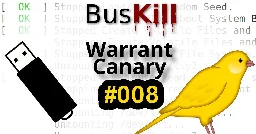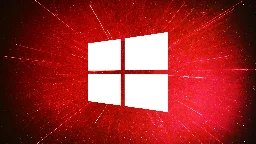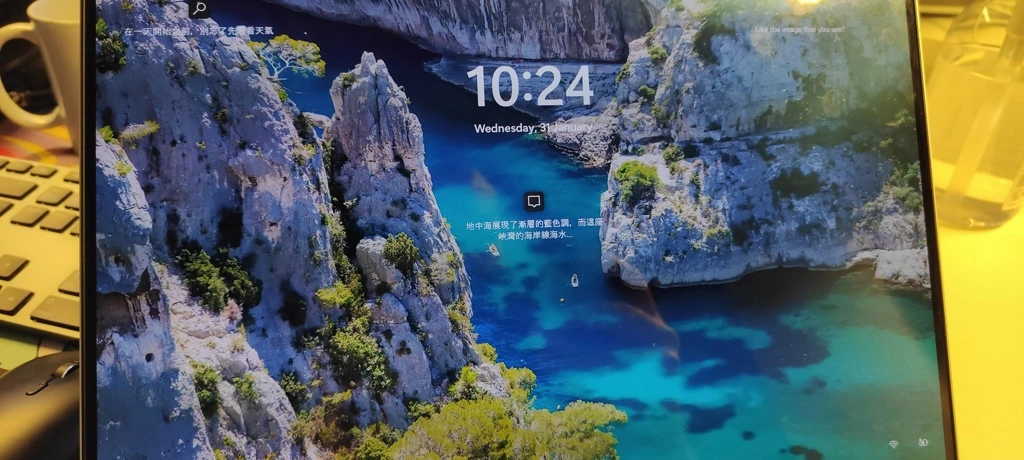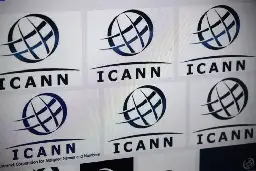
-
How to view Intune-managed firewall rules
Just a quick fyi for anyone using Intune to distribute firewall rules with the "Endpoint Protection > Windows Firewall" profile for the first time. Any rules you set won't be visible in the
wf.mscGUI or using PowerShell'sGet-NetFirewallRule.The only place you can see those rules is the registry under this key
HKEY_LOCAL_MACHINE\SYSTEM\ControlSet001\Services\SharedAccess\Parameters\FirewallPolicy\Mdm\FirewallRules -
BusKill Warrant Canary for 2024 H2 🕵️
www.buskill.in BusKill Canary #8 - BusKillThis post contains the cryptographically-signed BusKill warrant canary #008 for June 2024 to January 2025.

This post contains a canary message that's cryptographically signed by the official BusKill PGP release key
| [!BusKill Canary #008](https://www.buskill.in/canary-008/) | |:--:| | The BusKill project just published their Warrant Canary #008 |
For more information about BusKill canaries, see:
- <https://buskill.in/canary>
``` -----BEGIN PGP SIGNED MESSAGE----- Hash: SHA512
Status: All good Release: 2024-06-11 Period: 2024-06-01 to 2024-12-31 Expiry: 2025-01-31
Statements ==========
The BusKill Team who have digitally signed this file [1] state the following:
-
The date of issue of this canary is June 11, 2024.
-
The current BusKill Signing Key (2020.07) is
E0AF FF57 DC00 FBE0 5635 8761 4AE2 1E19 36CE 786A
-
We positively confirm, to the best of our knowledge, that the integrity of our systems are sound: all our infrastructure is in our control, we have not been compromised or suffered a data breach, we have not disclosed any private keys, we have not introduced any backdoors, and we have not been forced to modify our system to allow access or information leakage to a third party in any way.
-
We plan to publish the next of these canary statements before the Expiry date listed above. Special note should be taken if no new canary is published by that time or if the list of statements changes without plausible explanation.
Special announcements =====================
None.
Disclaimers and notes =====================
This canary scheme is not infallible. Although signing the declaration makes it very difficult for a third party to produce arbitrary declarations, it does not prevent them from using force or other means, like blackmail or compromising the signers' laptops, to coerce us to produce false declarations.
The news feeds quoted below (Proof of freshness) serves to demonstrate that this canary could not have been created prior to the date stated. It shows that a series of canaries was not created in advance.
This declaration is merely a best effort and is provided without any guarantee or warranty. It is not legally binding in any way to anybody. None of the signers should be ever held legally responsible for any of the statements made here.
Proof of freshness ==================
04 Jun 24 14:10:16 UTC
Source: DER SPIEGEL - International (https://www.spiegel.de/international/index.rss) Fortress Europe: Migrants Abandoned on the Edge of the Sahara Israel-Gaza-Krieg: Menschenrechtler Aryeh Neier über Schuldfrage und Strafverfolgung (Kopie)
Source: NYT > World News (https://rss.nytimes.com/services/xml/rss/nyt/World.xml) Middle East Crisis: Israeli Airstrikes Kill Iranian General in Syria Live Updates: India’s Election Results Suggest a Setback for Modi
Source: BBC News - World (https://feeds.bbci.co.uk/news/world/rss.xml) Shock for India's Modi as opposition set to slash majority Gaza ceasefire plan turns into deadly game of survival
Source: Bitcoin Blockchain (https://blockchain.info/q/latesthash) 000000000000000000014cd79802b29c1dcd7fc6debee1e3968cfc216b59bf16
-----BEGIN PGP SIGNATURE-----
iQIzBAEBCgAdFiEEeY3BEB897EKK3hJNaLi8sMUCOQUFAmZfIwgACgkQaLi8sMUC OQXZYA/9ElVoUy3Um3IXFSwUGO+ctkvKd6idD7RuOBjqZyfadr4emrDrfQKYbCpa Gik4M1H/GWobO/RaDjeSjQtGUmlPn8anhoFzmI6pPz7fBSfg5VGemllyHI2ypPpf cJ1jLrmzpDGxLqPd/R/WsoE8dY9E7q20JgNESAqEYyjmjxqOjx6EnIjBjy8u+xL3 YWBw5BQn/1XbLXw4X7WJNH1cNIIZDgePdIb8Wq6wEDTzFzAvfw5BPhJ2rVaChV9P 6d25htXLy5FU/qvomiy1C+ZskzbZPKGDNgr8lC/MPeNgLi0d/ps2Rgut/CGjKreW UiBmp3xslizR2/WhpRrcz0VLYxdNolfPY0odpgXkvQSEqGiZ1gOw5OQIN0f8HMiL nOXnnxFVgdO/I/x9X2DwKAGwuts/GSeWOHdeNxvflyDGEYJHt9YMT7kXcJ0/dl6z QSNHDoCMzMkxBCX23mlgY8pDSjw0Lqud0HDIChi1DFuNk7m1SfMIKGOn0ZAPsNqX RuMiLCMOPzdE8BBBpKFwZFtx0zyC78xAOBK1M8DqlUexT3CBGFjOwCmGY27dLFZe 6ygdrqptb5uDOXFsw63cWSOilCnEcx7M8FDX7QjuV6EUQwvsxpeKvHZIFVlJNQCX L5F8Lig/y4Q9iCjGiu3oT5zPuuEXPhKkyPsIeM9lC+zP/eC8rL4= =E7lp -----END PGP SIGNATURE----- ```
To view all past canaries, see:
- <https://www.buskill.in/category/Canary/>
What is BusKill?
BusKill is a laptop kill-cord. It's a USB cable with a magnetic breakaway that you attach to your body and connect to your computer.
| [!What is BusKill? (Explainer Video)](https://www.buskill.in/#demo) | |:--:| | Watch the BusKill Explainer Video for more info youtube.com/v/qPwyoD_cQR4 |
If the connection between you to your computer is severed, then your device will lock, shutdown, or shred its encryption keys -- thus keeping your encrypted data safe from thieves that steal your device.
-
VMware customers may stay, but Broadcom could face backlash “for years to come”
arstechnica.com Price hikes of over 2x widely expected under Broadcom’s VMware, survey finds300 director-level IT workers making VMware decisions were questioned.

Price hikes of over 2x widely expected under Broadcom’s VMware, survey finds
300 director-level IT workers making VMware decisions were questioned.
-
Req.Incoming Email NOT my Focus? Client/Server
Hello friends. Work email is crushing me. The ticketing systems, plural, email me on everyone's tucket. (Because some people only work tickets via email and others through the web interface.)
Are there any email clients or servers that allow new email to land somewhere other than the inbox? Or allow my view to start elsewhere?
I declare email bankruptcy daily....
Send whiskey.
Edit: I was unclear.
I have filtering, but those all happen after the mail is in the Inbox. I get a quarter second of crazy emails and previews and things moving, then they are gone. (Outlook sucks.)
I don't even want to see that shit. Not at all.
-
Dumb Q: How to manage sw licences?
Hello everyone, I hope I came to the right place to ask my stupid question. I'm currently working in a company that stuck way way back in time. I'm talking some people are still working in DOS level back in time. There is some revamping of this in progres, but it's going to be a long run.
The "IT department" (called computing department, lol) consist basically of 2 people, boss and me. Boss loves the old days, he's "happily" using Win XP on his computer and hates everything newer than Win7, although half of everything he tries to do doesn't work there anymore (and don't even start with security of the OS). Anyway... that's about the company background and what to expect.
During currently ongoing upgrades to get this company at least to 21st cwntury, there will be some sw licencing happening. I'm expecting like buying dozens of Office 2021 keys and some other standalone soft too. But there's problem with managing those keys, as there is no precedence, no rules and everything's going to be from the scratch almost. People are coming and going, PCs are dying (remember, there are still some DOS machines), hard drives replacing, etc. etc. Windows domain? Not in this company. Ever.
So, how do you keep track of what is installed and where? Thank you very much.
-
Would love some feedback on this UniFi setup
Hello!
My parents are moving to Italy and need a network. They only have 4G. I'm a little lost when it comes to UniFi and looking for some feedback if I've thought of everything and the setup works.
I was thinking Cloud Key 2, VPN Router Express, LTE Router UMR, maybe a U6 Lite AP to complement the one integrated into the Router if the range in the latter is insufficient, and a US-8-60W for power since only the cloud key and the AP would be powered using it. If they want cameras, I wanted to upgrade to CK2+, add G5 Bullets and use the US-8-150W instead.
I'm not sure whether I need the VPN router when the LTE router is already a router, too, but apparently the LTE router is not really integrated into the UniFi system. I need an AP, anyway, to the VPN Router is fine I think.
What do you think? Am I missing something? Thanks in advance.
------
Wait, is the UDR sufficient for the first setup? No cloud key, no vpn router, no switch...
-
r/sysadmin and the size of this community
So I have been a part of this community for a while and it seems pretty quiet. I know Lemmy is not as big as Reddit so this community will always be much smaller but I kind of miss the activity on r/sysadmin. Infinity for Reddit still works for view only so I have been scrolling though posts on Reddit as some of the stories and discussion there are fun to read.
With that being said, I think we can work to grow this community a bit. From what I can tell this community is home to a lot of quick posting. I am responsible somewhat as I have posted a bunch of articles. However, I am going to make a point to do longer write ups and I think it would be good we posted some stories. Additionally, I would be more than happy to help setup automatic posting for patch Tuesdays and similar scheduled posts.
As far as growth goes, I think we need to get the word out. A lot of people just do not know that Lemmy is a thing. If we can create some more meaningful posts and get some people to come over here from other platforms then I think this community will grow. I also know that mastodon is a pretty big platform so if we can get some people to engage from mastodon it will help as well.
-
New Samba community
I have created a new Samba community on lemmy.sdf.org
You can find it here:
My goal is to create a support network that is outside of the mailing list.
-
VMware security advisories are now non public (from Reddit)
The location of VMware Security Advisories (VMSAs) has changed on May 6, 2024. They are now available from the Broadcom Support Portal. The legacy VMSA URLs still work but are now redirected to the portal, for example: https://www.vmware.com/security/advisories/VMSA-2024-0002.html points to https://support.broadcom.com/web/ecx/support-content-notification/-/external/content/SecurityAdvisories/0/23681.
https://blogs.vmware.com/security/2024/05/where-did-my-vmware-security-advisories-go.html
Edit: This Post covers what's going on. (thanks to /u/lost_signal and /u/RoomStrange6413)
Sourced from https://www.reddit.com/r/sysadmin/comments/1cn3uhw/vmware_security_advisories_vmsas_are_now_to_be/
-
I had to migrate from Samba AD to Windows Server AD and I'm sad (RIP Samba)
Samba is amazing, Windows server is a lot less so. The problem with Windows server is that it takes tons of steps to do basic things. On Samba I had Samba tool and it was very nice and friendly. On Windows server you have a ton of different management panels.
If there was a way I could hold off I would but due to changing requirements I didn't have much of a choice. (We needed Windows Server bare metal and I was not about to go and buy another machine.)
-
How to learn Windows?
Hey all!
I’m a long time Linux user, and I’ve been avoiding it for the good part of the last ~15 years. Most of my Windows experience is from the XP times.
I’ve changed careers from agriculturing to ICT a few years ago (almost done with school), and while I can say I know my way around Linux pretty well, Windows is an alien landscape to me.
I got a job a few years ago as sysadmin (not so much, but still) / IT-support (more), and I find myself struggling to help customers with Windows / handle Windows servers. I would like to change that.
I have no intention on moving my personal computing to Windows due to privacy concerns, which is a bit contradictory to my goals, because AFAIK learning things this way is the “best” approach. It was the case with Linux for me, at least.
While i do learn Windows at my job, I’d like to compliment it with another approach, too.
Do you guys have any suggestions how I could learn Windows (the whole ecosystem, not just end-users computers)? I’d like it to be fun, as I get bored easily (breaking my Linux time and time again was really fun learning method) Maybe fire up some VMs and go from there, somehow? What do you think are the most essential skills for a Windows sysadmin? Active Directory, sure, but what else?
- fedoramagazine.org Joining Fedora Linux to an enterprise domain - Fedora Magazine
Learn how to join your Fedora Linux machines to an enterprise domain and manage them with Fleet Commander.

- www.bleepingcomputer.com New Windows driver blocks software from changing default web browser
Microsoft is now using a Windows driver to prevent users from changing the configured Windows 10 and Windows 11 default browser through software or by manually modifying the Registry.

-
Backdoor found in widely used Linux utility breaks encrypted SSH connections | Ars Technica
arstechnica.com Backdoor found in widely used Linux utility breaks encrypted SSH connectionsMalicious code planted in xz Utils has been circulating for more than a month.

Hopefully this does not affect you but if you are running something like Arch, OpenSUSE tumbleweed, Debian sid or Fedora Rawhide and use SSH for remote access you should do a full wipe.
-
VMware may be getting rid of Skyline
I received the below message. It states Skyline Advisor Pro can't be activated after 4/1. This doesn't look good for the Skyline program. I've been using it for a long time and between log assist and the recommendations, i've found it very helpful. I have the Dell integration in place but I haven't really used it much. It's unfortunate that this appears to be getting set out to pasture.
--------------------------
We would like to inform you of some upcoming changes to VMware Skyline's functionality and features, scheduled to take effect on or before April 1, 2024.
These changes are necessary as part of our VMware by Broadcom vision for the future of self-help issue avoidance and diagnostics for VMware Cloud Foundation and VMware vSphere Foundation.
Feature Changes 1 VMware Select Support Effective immediately, Skyline now supports VMware Select Support. This replaces VMware Success 360 (S360) Support, which reached End of Sale (EOS) in May 2023. As with S360 Support, Select Support provides access to Insights Reports, providing insights into the health and performance of your VMware infrastructure.
We highly recommend linking your Select Support Entitlement Account to your CSP Org as soon as possible to ensure seamless access to Skyline's proactive support and Insights Reports.
2 Availability After April 1, 2024
• Skyline Advisor Pro will remain available and fully functional for existing customers.
• Activation of new Skyline Advisor Pro services in new or existing CSP organizations will be discontinued and no longer available.
3 Active Skyline Organizations
Active Skyline Advisor Pro organizations will automatically be upgraded to Select Support level experience in Skyline and have access to Insights Reports. No action is required.
4 Inactive Skyline Organizations Skyline Advisor Pro organizations in an inactive state will be removed from the service.
Customers that have allowed their Skyline service to expire beyond the 60-day grace period must renew their access before April 1, 2024, to continue using Skyline.
5 Organizations in Limited Mode
Skyline Advisor Pro organizations in Limited Mode will be automatically renewed to Skyline at Select Support level experience to ensure full access. No action is required.
6 Technical Adoption Manager (TAM) Engagement
The process for TAM activation will be streamlined. Customers will now have full control over enabling TAM Reports. Once you opt in, no further action is required. The assigned TAM will have access to perform required duties as needed.
7 Integration with Dell's Secure Connect Gateway 5.0
Skyline Advisor Pro's integration with Secure Connect Gateway 5.0 will be discontinued due to the strategic direction of VMware Skyline.
VMware Skyline continues to provide proactive self-service support for your VMware environment. These changes will help deliver on the roadmap for self-help issue avoidance and diagnostics for VMware Cloud Foundation and VMware vSphere Foundation. Please do not hesitate to reach out to our Skyline Community for assistance. We are committed to minimizing any disruptions to your operations.
Thank you for your continued trust in VMware Skyline.
Best Regards, VMware Skyline Team
-
VMware got Broadsided and Alternatives in the Post ESXi Era - Everything MSP

YouTube Video
Click to view this content.
-
Flex 170 GPU from Intel - Subscription Free GPU Accelerated VDI on Proxmox 8.1 - YouTube

YouTube Video
Click to view this content.
Here is a video about Intel VDI.
-
Suggestions for cheap enterprise grade hardware to run linux headless.
Basically what it says in the title. I did a lot of searching in Internet. I think small form factor computers are mt best bet. But I still feel they are costly for my purpose.
I am going to be running some ansible playbooks periodically on the machine. SBCs i looked at either had very high specs for this use case and thus higher price or they had other fratures i dont want like - wifi, graphics card etc.
I am preferring enterprise hardware because this would eventually be used in business where people will not settle for anything less.
- www.bleepingcomputer.com Microsoft rolls back decision to stop Windows 11 22H2 preview updates
Microsoft says that systems running Windows 11 22H2 will continue to receive non-security preview updates after initially stating they would no longer receive them after February 2024.

- www.nist.gov NIST Releases Version 2.0 of Landmark Cybersecurity Framework
The agency has finalized the framework’s first major update since its creation in 2014.

NIST is a US government org that releases industry guidlines on best practices for cybersecurity.
I know that infosec and sysadmin work aren't the same, but in my experience it often falls to sysadmins and systems engineers to fill the gaps. Hope this is useful.
-
Samba AD via Nix os
I would never put Nix os into production as it is fairly obscure but since there was a interest here in Samba AD I though this might be interesting to some
-
Anyone switched to Debian?
Debian has less complexityand is very stable. It has a nice wiki and a Debian system can run for a few years on unattended upgrades.
Edit: this post was originally about cost savings but that is not really a useful metric
-
Exporting Sharepoint Online folder permissions to Excel.
Hey guys,
Because of the unclear nature of Sharepoint folder permissions we want to make an export to Excel of each folder and the appropriate rights. Explicit rights only is fine but everything together is also fine.
Having tried and tested for hours I cannot seem to find a working script. Using outdated functions, random errors, etc.
Does anyone know a working script for this? A commercial solution (that does nog charge 4000$per year) is also fine. This is becoming an expensive headache for me.
I have already tried all the usual Google hits as well as ChatGPT. None seem to work but also not work with modern authentication when connecting to Sharepoint using Powershell for example which leads me to suspect they are too old.
-
On Call Sleep Question
If you are on call and you receive a call at say 3:45 am and you resolve the issue by 4:30 am. Is it then worth trying to go back to sleep to wake up for work the next day or should you just stay awake and power through it?
I'm asking because this happened to me and I went back to bed, did not feel tired at all and when I eventually fell asleep I got maybe an hour of extra sleep and I felt like complete garbage when my alarm went off and pretty much like that for the remainder of the day. Whereas I feel like if I just stayed awake for the extra time after 4:30 am I might have not felt as bad?
What are your opinions on this?
Edit: I'm appreciating all the responses and taking the information in. Sounds like this is not a clear cut case that is a simple yes do this or no don't do that.
-
Good hosting?
Does anyone have recommendations for good VPS Linux hosting places? I used to recommend DigitalOcean, but I'm having a subpar support experience currently that sets off some slight alarm bells such that I might want to look elsewhere. What's good?
-
Lenovo starts displaying text in chinese


Honestly all new lenovos have been giving me issues, webcams break, stop charging, except for those black thinkpads.. This one suddenly decided to go display Chinese text and display goes black randomly
-
Anydesk 8 removes TCP Tunneling from the free service.
Have been using this for occasional outside broadcasts. It stopped working today. Downgrading to version 7.0.4 fixed it for now. Unfortunately Rustdesk doesn't support reverse tunnels so I'll have to hunt for an alternative method.
- www.theregister.com ICANN proposes creating .INTERNAL domain
The plan is to keep the world at bay by never recording it in the DNS root – like many already do with a subdomain for an intranet

-
What do you use to track BMCs/KVMs/IPMI?


I manage hundreds of servers at work. They each have a BMC (remote power on/off, reset, KVM, etc) and we need to use those features frequently. I've been using a Google Docs spreadsheet to track their URLs, what each box is used for, specs, etc but it feels like a dynamic web app would be better for this purpose. Does anyone use anything like this? Did you make your own?
-
What crazy or unusual things are you guys working on?
I read someone was trying to get Samba AD working in a container and now I am curious what else you guys are working on.
(PS: If that someone is still working on it you might try running DNS and LDAP in separate containers with samba running bare metal. Samba nor Linux supports windows distributed filesystems so you likely need either a central file share or rsync.)
-
Leaving VMware? Consider these 5 FOSS hypervisors • The Register
www.theregister.com Leaving VMware? Consider these 5 FOSS hypervisorsThese suggestions are like our principles. If you don't like 'em ... we have others

-
What are you guys using for RMM these days?
I'm looking into building a new remote management with mesh VPNs but it may turn out not to be practical.
-
VMWare FUD. Anyone moving away from it professionally?
I've been seeing a lot of doom and gloom about VMware. The cutting of services and licensing changes of the cost of core offerings are huge issues. Is anyone planning or budgeting to change to another hypervisor? If so what?
-
Rustdesk: a open source remote desktop software
About a year ago I introduced Rustdesk as an experiment. For those who don't know Rustdesk is a piece of software that allows remote access. You can use the public servers or you can use your own private server.
It has been a massive success and a game changer in my company. The biggest benefit to Rustdesk is that it allows you not only to share your screen but to connect to other peoples screens. That doesn't sound like much of a game changer but having a simple UI that can be taught to people that aren't tech savvy is very useful. It has powered collaboration internally.
I just thought I'd share my experiences.
-
How often do you make a back up?
I was wondering how often does one choose to make and keep back ups. I know that “It depends on your business needs”, but that is rather vague and unsatisfying, so I was hoping to hear some heuristics from the community. Like say I had a workstation/desktop that is acting as a server at a shop (taking inventory / sales receipts) and would be using something like timeshift to keep snapshots. I feel like keeping two daily and a weekly would be alright for a store, since the two most recent would not be too old or something. I also feel like using the hourly snapshots would be too taxing on a CPU and might be using to much disk space.
-
Tailscale as a tool for PCI compliance (to avoid port forwarding)
So I recently discovered that the camera NVRs are majority insecure. This lead to my company failing to get PCI compliance which wasn't all that unexpected. However, this leads to the awkward situation of me comparing mesh VPNs. I've been playing around with netbird but I'm looking for a more polished solution.
Do any of you use Tailscale in a corporate environment? If so how well does it work and is there any major pain points?
Edit: I gave up on Tailscale as it was a pain in the ass. I'll just use Netbird with a reverse proxy for the cameras.
-
Sunshine streaming for employee remote work?
Has anyone used sunshine/moonlight for low latency remote desktop? I've used it for remote gaming but I since I've had good experiences I though it might be testing for work.
For testing I've used it to access my local machine but that's it.
-
Happy New Year!
It's the last Friday before the New Year. Like myself, many of you will be starting their on-call rotation.
To all my brothers and sisters in arms, I wish you a quiet and relaxing New Year's weekend. May your DNS be accurate, your switches be resilient, and your uptimes be high.
Cheers!